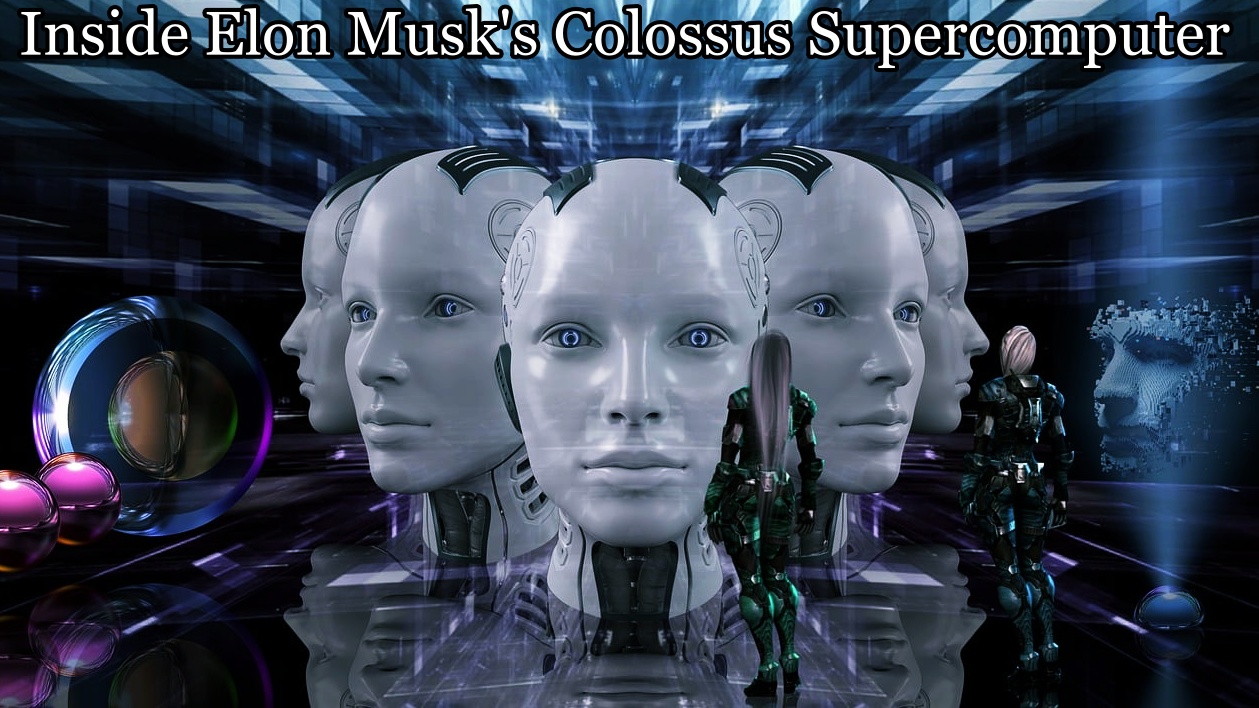Elon Musk, through his XAI startup, has unveiled what is now the largest and most powerful artificial intelligence training supercomputer in the world. Named Colossus, this technological marvel is equipped with cutting-edge Nvidia GPU hardware, liquid cooling, and powered by giant Tesla MegaPack batteries.
Musk’s vision for Colossus is to create an AI capable of solving the mysteries of the universe, and what we see today is only the beginning.
Inside Colossus: The AI Supercomputer of the Future
Colossus is located in Memphis, Tennessee, at an industrial park southwest of the city center, situated along the mighty Mississippi River. The building, previously home to Electrolux, a Swedish appliance manufacturer, was repurposed for the XAI project. Why Memphis? It came down to finding the perfect building to get the project running quickly—it’s not about Austin, it’s about practicality.
Despite its unassuming exterior, Colossus houses the world’s largest AI training cluster. Inside, you’ll find over 1,000 Nvidia HGX units connected to exabytes of data storage and integrated into a super-fast network. Nvidia’s CEO Jensen Huang himself has praised Colossus, calling it “easily the fastest supercomputer on the planet.”
The Hardware: What’s Inside Colossus?
Massive Scale and GPU Power
At the heart of Colossus is the GPU cluster, designed to power Gro—an advanced AI model being developed by XAI. Colossus currently houses over 2,500 Nvidia H100 GPUs across four massive data halls. Each data hall is packed with:
- Nvidia H100 GPUs (the latest in AI training technology)
- Storage (massive exabytes of data)
- Fiber optic networks for rapid data transfer
The GPUs are cooled by a liquid cooling system, where water is pumped through giant pipes beneath the GPU cluster. The system works by drawing excess heat from the GPUs, circulating it through a chiller to cool it down before it’s pumped back in.
This liquid cooling approach is far more efficient than traditional air cooling methods used in most data centers. As a result, Colossus can handle the intense heat generated by such a massive AI training system.
Advanced Rack Design for Seamless Maintenance
Each GPU rack in Colossus is built with eight Nvidia H100 GPUs, housed within individual serviceable trays. This design makes maintenance a breeze, as technicians can pull out and service a rack without needing to shut down the entire system. This unique setup ensures minimal downtime, which is critical for maintaining the high-performance requirements of AI training.

The Data Hall: Powering AI at Unprecedented Speeds
Colossus’s data hall features a raised-floor configuration, dividing the facility into three distinct sections:
- Above: The power system.
- Below: The cooling system.
- Middle: The GPU cluster.
This setup maximizes the space and efficiency of the system, ensuring a seamless flow of both data and power.
Water-Cooled GPU Racks
Each of Colossus’s GPU racks has its own independent cooling system. The system uses a cold water delivery system (blue tubes) to cool the GPUs and a hot water extraction system (red tubes) to remove the excess heat. This allows each rack to be serviced independently, making Colossus one of the most efficient AI supercomputing systems ever built.
Data Storage and Networking: Exabytes of Information at Lightning Speed
The data used to train Grock is stored in an exabyte-scale storage system, with each server accessing this data over an ultra-fast network powered by Nvidia BlueField 3 DPUs (Data Processing Units). These DPUs handle 400 Gbps of data transfer, ensuring that the system can manage the vast amounts of data AI models require for training.
Colossus uses ethernet and fiber optics for scaling beyond traditional supercomputer systems, enabling the AI to process petabytes of data with unparalleled speed.
Tesla Power: The Energy Backbone of Colossus
What powers Colossus is just as revolutionary as its hardware. Instead of relying on traditional power sources, XAI uses Tesla MegaPack batteries to ensure consistent, high-performance energy delivery.
This solution was necessary after power fluctuations from the grid began affecting Colossus’s performance. Even tiny power variations caused inconsistencies in the AI training process. By routing energy through Tesla MegaPacks, Colossus receives steady, uninterrupted power, ensuring maximum efficiency during training sessions.
Tesla Batteries: Ensuring Uninterrupted AI Training
Each Tesla MegaPack battery unit stores energy, which is then fed directly to Colossus. This system not only provides a stable energy flow but also offers the flexibility to scale rapidly as Colossus expands—XAI is set to double the size of Colossus to include over 2 million H100 GPUs in just two months.
The Growth of XAI and the Future of Artificial Intelligence
XAI, which raised $6 billion in venture capital last year, is valued at around $24 billion. With plans to grow further and increase its reach, XAI is positioning itself as a major player in the AI arms race.
Gro: The Chatbot that Evolved Into a Visionary AI
Gro, XAI’s flagship AI model, is evolving rapidly with the power of Colossus. Recently, Gro was upgraded to handle vision capabilities, allowing the AI to interpret images, in addition to its existing text-processing features. This new functionality has been integrated into XAI’s social media platform, X, allowing premium users to interact with Grock by asking it questions about images in posts.
Artificial General Intelligence: A New Era
The ultimate goal for Musk and XAI is to create Artificial General Intelligence (AGI)—an AI that can perform virtually any cognitive task that a human can. AGI would possess all human knowledge and be capable of learning, adapting, and solving problems in ways that humans can’t even imagine.
In Musk’s words, AGI is the key to unlocking the mysteries of the universe, and Colossus is the platform that will take humanity one step closer to this monumental leap in technology.
The Battle for AI Supremacy: A Challenge to OpenAI
As Colossus ramps up, industry leaders like OpenAI are feeling the pressure. Reports suggest that OpenAI CEO Sam Altman has expressed concerns to Microsoft executives that Elon Musk and XAI may soon overtake them in access to computing power, which could dramatically shift the AI landscape.
XAI’s Explosive Growth and Future Prospects
XAI’s rapid growth and Musk’s bold plans to scale Colossus have caught the attention of the global tech industry. The company’s $24 billion valuation could grow significantly in the near future, potentially reaching $40 billion as XAI continues to dominate the AI space.
Conclusion: Colossus Is Just the Beginning
With Colossus, Elon Musk and XAI are setting the stage for the next era of artificial intelligence. From the massive GPU clusters to the cutting-edge liquid cooling system and Tesla MegaPack power delivery, Colossus represents the future of AI training and computation.
As the AI race accelerates, all eyes will be on Musk’s ambitious plans and the rapidly evolving capabilities of Gro. Will Colossus lead the way toward Artificial General Intelligence, or will it spark an entirely new technological revolution?
FAQ – Elon Musk’s Colossus
Colossus is the world’s most powerful AI training supercomputer built by Elon Musk’s XAI startup. It is designed to power advanced AI models like Gro and solve complex challenges, with a massive GPU cluster and cutting-edge liquid cooling technology.
Colossus is located in Memphis, Tennessee, in an industrial park along the Mississippi River. The building was originally used by Electrolux before being repurposed by XAI for the AI supercomputer.
Colossus is equipped with over 1,000 Nvidia HGX units and 2,500 Nvidia H100 GPUs, all connected to exabytes of data storage. It uses an advanced liquid cooling system and a super-fast fiber optic network to manage the massive data flow.
Colossus uses a liquid cooling system, where cold water circulates through pipes beneath the GPUs to draw out the excess heat. The water is then chilled and pumped back into the system, ensuring optimal temperature for the GPUs to function efficiently.
Gro is an advanced AI model developed by XAI, and it’s being powered by Colossus. Initially designed as a chatbot, Gro has evolved to include vision capabilities, allowing it to analyze images in addition to text, and is integrated into the X social media platform.
Colossus is powered by Tesla MegaPack batteries, which provide stable, uninterrupted power to the system. This solution was implemented to prevent power fluctuations from the grid, which could interfere with the AI training process.
XAI’s goal with Colossus is to create Artificial General Intelligence (AGI)—an AI that can perform virtually any cognitive task a human can. This would unlock new possibilities, including solving complex global challenges and understanding the mysteries of the universe.
These FAQs cover the key points about Colossus, its hardware, its purpose, and its connection to Elon Musk’s broader vision for AI.
Read More:

